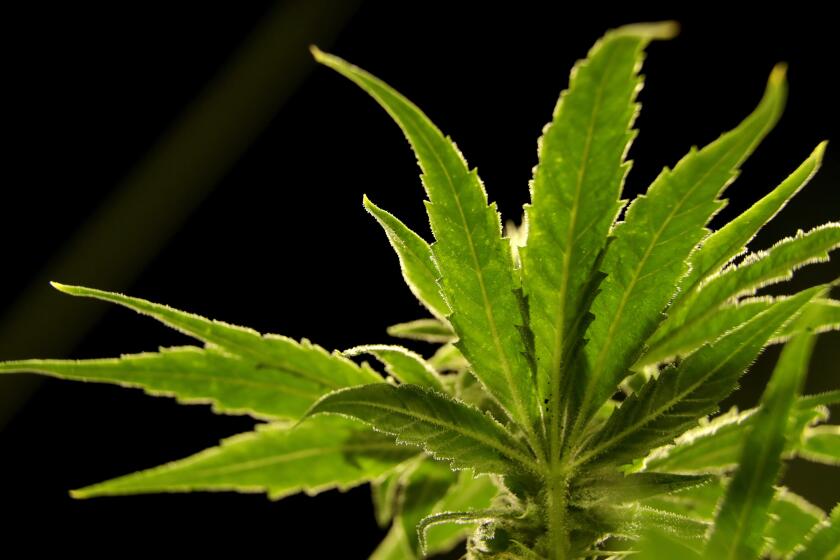O.C. Patient Says Anti-Pot Policy Is Hazardous to Health
Gary Romero says he’s never been much of a rabble-rouser, and he’s not much of one now, even as he talks of a government quietly going back on its promise to give him marijuana to help him fight AIDS.
Certainly there is indignation in his voice, but it is softly spoken, edged with fear. None of this, he says, makes any sense.
“The government, to me, shouldn’t have the right to tell me that I can’t feel better now,” he says of Washington’s recent move to end a little-known program of supplying marijuana to the seriously ill.
Romero was diagnosed as having AIDS three years ago in July. Illegal marijuana, he says, is the reason that he is still alive, why he has not “wasted away” like so many others who have traveled this path. It stimulates his appetite, he says, calms his nausea and helps him to sleep.
Romero’s T-cell count, that grim immune system gauge that AIDS patients use to figure their chances of staying alive, is 20. A healthy person’s stands in the range of 1,000. Still, Romero’s weight is within the normal range for his height. He hasn’t had a cold for a year.
“I think people should know about us being denied (legal marijuana) and how it really helps me,” he says.
Then he lights a half-smoked marijuana cigarette that he rolled earlier in the morning and doses himself with four quick hits. Romero, a former Marine and computer software salesman, says he is planning on turning 40 next month.
“I am careful to only keep enough here for my own personal use,” he says, warily, from his Fullerton home. Yet he lives in fear of eviction and, possibly, arrest.
Last year, the federal government agreed with Romero and his doctor that marijuana, for him, was a good thing. The Food and Drug Administration approved his application to smoke marijuana for medical reasons and within 30 days issued him a so-called Investigative New Drug number, 36288.
It said Romero could get his marijuana from the government, grown at a research farm in Oxford, Miss., free of charge. The government is barred from selling illegal drugs.
Then after months of going back and forth with three different government agencies, the National Institutes of Health called Romero’s doctor three weeks ago to tell him that marijuana would no longer be supplied through the Compassionate IND Program. So Romero never did get his free pot. The government’s reason: Smoking marijuana is bad for people’s health.
The Public Health Service, which is under the aegis of the Department of Health and Human Services, says THC, the mind-altering substance in marijuana, is available in pill form and that this should be used instead.
But many patients and their doctors say that the costly pills, available since 1985, don’t work as well, if at all. Patients with severe nausea have trouble keeping swallowed medication down.
The policy change on medical marijuana use came to light March 10 during a routine press briefing by a Public Health Service spokesman. A week later, the Drug Enforcement Administration said marijuana would remain classified an illegal drug with no accepted medical use.
But Gary Romero is not the only one left out by the move. The FDA had approved at least 27 other seriously ill or disabled Americans for legal marijuana use before the government said, in essence, that it had changed its mind.
“There was quite a bit of discussion about whether we should go back on our word to these 28 people,” Public Health spokesman Bill Grigg says. “But then we said, ‘Heck, if this is harmful to additional people, isn’t it better to go back on our word?’ ”
All of the people approved for legal marijuana use suffer from cancer, glaucoma, acquired immune deficiency syndrome, multiple sclerosis, paralysis or other disorders. Many are dying, all experience pain. Marijuana, they and their doctors report, soothes their nausea, their spasms, holds off blindness, stops their pain, stimulates their appetite and keeps up their weight.
Grigg says that there are 13 other patients who were already receiving marijuana through the program before the review and that they will still be supplied. These patients, however, are wary.
“The government has turned compassion into a cheap con game, and patients have been suckered into it,” says Bob Randall, head of the Alliance for Cannabis Therapeutics in Washington, who is also legal marijuana user No. 1.
Randall successfully sued the government for the right to smoke marijuana to treat his glaucoma 15 years ago. As part of the settlement of Randall’s case on appeal, the Compassionate IND Program was put into place.
It was the arrest of Kenny and Barbra Jenks, the first AIDS patients to be supplied with government marijuana, that most recently focused this dilemma in the public eye. Kenny Jenks, a hemophiliac who contracted AIDS through a blood transfusion, infected his wife before he knew he had the disease.
Narcotics agents broke down the door of the couple’s home in Panama City Beach, Fla., held them at gunpoint and then arrested them for growing two pot plants. The Jenks’ 1990 marijuana conviction was reversed on appeal, and the appellate decision was upheld by the Florida Supreme Court.
AIDS patients, especially, were intrigued by the Jenks case. Many of their physicians began applying to the FDA for legal access to the drug. Did the government really want to get into supplying marijuana on a potentially grand scale? Government officials concede that they were concerned about the message that this would send. Marijuana, in the government’s official view, is no different than LSD and heroin, all listed by the DEA as Schedule I.
Cocaine, on the other hand, is classified as a Schedule II drug, which while still illegal to the general public, means that doctors may prescribe it for medical use. Eye surgeons do just that. A Schedule II drug, which also includes morphine and methadone, is more readily available for research purposes as well.
This is a situation that patients such as Gary Romero describe as a Catch-22. Although anecdotal evidence on marijuana’s medical usefulness has been accumulating for years, they say, the government, despite several court decisions supporting its therapeutic use, has consistently taken a hard line against the drug.
Many doctors do not like to discuss its medical uses at all.
“I have asked 10 doctors to help me apply to get marijuana legally,” says Montica Fankell, a quadriplegic in Yucaipa, Calif., who, like many other paralyzed Americans, smokes marijuana to control spasms and pain.
“None of them would,” Fankell says. “Even if they are interested, they finally decide that it is too much red tape.”
In 1988, Francis Young, the DEA administrative law judge, ruled that physicians should be allowed to prescribe marijuana for their patients, adding that it would be “unreasoning, arbitrary and capricious for DEA to continue to stand between those sufferers and the benefit of this substance.”
“In its natural form,” the judge said, marijuana “is one of the safest therapeutically active substances known to man.”
The DEA refused to follow Young’s recommendations, and last year a federal appeals court ordered the DEA to reconsider. DEA Administrator Robert Bonner did that earlier this month, basing his decision on the same testimony and documents used by Young. But he reached the opposite conclusion.
Bonner said marijuana was likely more carcinogenic than tobacco, that it damages brain cells, causes lung problems, dizziness and fatigue, muddles thinking, lowers blood pressure and impairs motor skills.
He said claims that marijuana is good medicine “are false, dangerous and cruel. Sick men, women and children can be fooled by these claims and experiment with the drug. Instead of being helped, they risk serious side effects. It is a cruel hoax to offer false hope to desperately ill people.”
The government, however, is clearly not of one mind when it comes to marijuana as medicine.
While the medical marijuana policy was under review earlier this year, the White House Office of Drug Control Policy accused Dr. James O. Mason, the Public Health Service chief, of an “intolerable lack of compassion” for not supplying the drug to approved patients at once.
Many physicians who treat the seriously ill say that regardless of marijuana’s social stigma, there are too few reliable studies on the drug’s effectiveness to determine whether it would be useful in patient treatment plans. A surprising number, however, are apparently willing to take a chance.
In a study published in the Journal of Clinical Oncology last July, two Harvard researchers found that 44% of surveyed cancer specialists had recommended smoking marijuana to relieve chemotherapy nausea. Forty-eight percent said they would prescribe it in some cases if it were legal to do so, and 54% said they supported this change.
Dr. Steven Armentrout, a cancer specialist at UCI Medical Center in Orange, says he has had good results treating nausea from chemotherapy with Marinol, the anti-nausea pill the government recommends, and doubts how beneficial smoking marijuana would be for cancer patients today.
“One wonders how many of marijuana’s benefits are psychological and how many are physiological,” Armentrout says. “But that’s OK.”
Dr. Sherman Williamson, an Orange County physician who has treated hundreds of AIDS patients, compares the medical community’s general timidity to advocate marijuana use to the dilemma over administering narcotics for pain. Moderation, even when treating the terminally ill, is often a goal.
“To me it is obvious. If you have got no reasons not to do it and you are aware of the ramifications legally, I would do it,” Williamson says. “I can’t prescribe marijuana now. But if I felt it had some benefits, I would do it.”
Williamson says that he has tried prescribing Marinol to his AIDS patients who are “wasting away” and has been unhappy with the results.
The NIH just announced that it will begin clinical trials with AIDS patients to determine if Marinol and megace, a synthetic hormone used to treat advanced breast cancer, is useful in combatting the wasting syndrome of which Williamson speaks. No trials with smoked marijuana are planned.
The American Cancer Society, while supporting further research, says it does not favor making marijuana available as medicine. The American Medical Assn. takes a similar stand.
In an indication of a possible softening of that position, however, delegates to the California Medical Assn.’s annual House of Delegates meeting in Anaheim earlier this month passed a resolution calling for a “comprehensive study” to determine when prescribing marijuana for patients might be beneficial.
But all of this, say patients such as Romero and hundreds of others, takes more time than they have to spare. They say they will remain criminals by smoking marijuana outside the law.
They say they have no other choice, for now.
More to Read
Start your day right
Sign up for Essential California for news, features and recommendations from the L.A. Times and beyond in your inbox six days a week.
You may occasionally receive promotional content from the Los Angeles Times.






